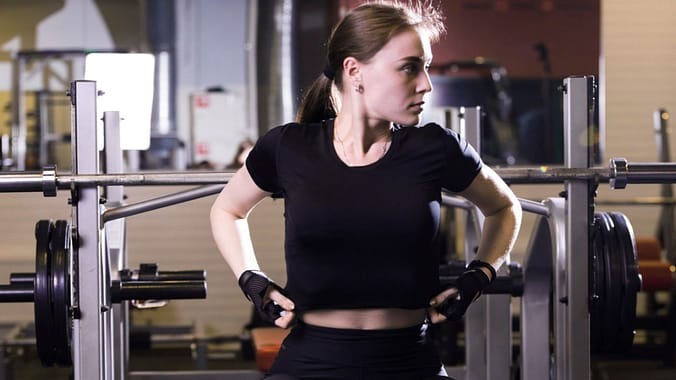
Table of Contents
Toggle1. Back Squats
Back squats are foundational for building lower body strength, targeting the quadriceps, hamstrings, glutes, and lower back. Performing back squats with proper form and progressively increasing the weight can help in developing overall leg strength, which is crucial for explosive sprinting power.
2. Front Squats
Front squats emphasize the quadriceps and engage the core more intensely than back squats. This variation can enhance your ability to maintain an upright posture while sprinting and improve your acceleration and power output.
3. Box Squats
Box squats involve squatting onto a box or bench, pausing briefly before standing back up. This variation helps in reinforcing proper squatting mechanics, builds explosive strength from a static position, and can translate into faster sprint times.

4. Split Squats
Split squats or lunges target each leg individually, aiding in balance and addressing any strength imbalances between your legs. This variation helps improve stride length and overall stability while sprinting.
Safety and Technique
Regardless of the squat variation chosen, focusing on proper technique is crucial to prevent injury and maximize gains. Ensure your knees track over your toes, maintain a neutral spine, and engage your core throughout the movement.
Comprehensive Training Approach
While squats are valuable, a holistic training program should include various exercises targeting different muscle groups involved in sprinting. Incorporate plyometrics, sprint drills, agility work, and strength training for the core and upper body to achieve a well-rounded improvement in sprint speed.
Incorporating the right squat variations into your training routine, along with a well-rounded approach to sprint training, can significantly contribute to improving your sprint speed and overall athletic performance.
Let’s dive deeper into the essence of sprint speed enhancement through specific squat variations and their impact on an 18-year-old’s training regimen.
Understanding the Mechanics
Sprinting is a complex movement that requires explosive power, coordinated muscle activation, and efficient biomechanics. Squats serve as a fundamental exercise to enhance the strength and power needed for sprinting.
Squat Depth and Speed Development
The depth of your squat matters when aiming to improve sprint speed. Studies suggest that partial squats focusing on the top half of the movement can be particularly beneficial for enhancing sprint performance. These variations mimic the joint angles and muscle activations used during the acceleration phase of sprinting.
Speed-Strength Continuum
It’s crucial to understand the speed-strength continuum in relation to squat variations. For sprinting, the focus should lean towards exercises that enhance speed-strength, emphasizing explosive power generation. Box squats, jump squats, or even assisted jump squats with bands can effectively target this aspect.
Incorporating Plyometrics
Pairing squat variations with plyometric exercises can amplify their effectiveness. Plyometric movements like depth jumps, bounding, or single-leg hops complement squat variations by enhancing the stretch-shortening cycle of muscles, leading to greater force production and faster sprinting.
Training Frequency and Recovery
While squat variations are potent tools, overtraining can hinder progress and increase the risk of injury. A balanced approach with adequate rest and recovery is vital. Aim for 2-3 sessions per week focusing on squat variations while allowing ample recovery time between workouts.
Periodization and Progression
Periodizing your training by varying intensity, volume, and types of squat variations can prevent plateaus and continuously challenge your muscles. Gradually increasing the load, incorporating different variations, and adjusting rep schemes contribute to consistent improvements.
Summary
In summary, selecting squat variations tailored to enhancing speed-strength, explosive power, and biomechanical efficiency is key for an 18-year-old aiming to improve sprint speed. However, remember that no single exercise guarantees success; a comprehensive approach that includes a variety of training methods is crucial for optimal sprint performance.
External Resources:
For further exploration and guidance on sprint speed enhancement through squat variations and related training methodologies, refer to the following resources:
The Role of Strength Training in Sprinting
Plyometric Exercises for Speed and Power
Sprinting: A Biomechanical Approach – National Center for Biotechnology Information
Speed Training: Improving Acceleration – Active.com
Strength Training for Sprinters – Runner’s World
How to Increase Your Sprinting Speed – Healthline
Comparison tabular
Here’s a comparison table summarizing the key aspects of various squat variations for improving sprint speed:
| Squat Variation | Primary Muscles Targeted | Benefits | Considerations |
|---|---|---|---|
| Back Squats | Quadriceps, Hamstrings, Glutes, Lower Back | Builds overall leg strength, essential for power generation | Ensure proper form to prevent lower back strain |
| Front Squats | Quadriceps, Core | Emphasizes core engagement, aids in upright posture during sprinting | Requires flexibility and wrist mobility for the front rack position |
| Box Squats | Lower Body (Quads, Glutes, Hamstrings) | Enhances explosive strength, reinforces proper squatting mechanics | Proper box height crucial to achieve desired depth |
| Split Squats | Quadriceps, Hamstrings, Glutes | Addresses leg strength imbalances, aids in balance and stability | Focus on form to prevent knee instability |
Comparison Overview:
Primary Muscles Targeted: Each variation targets specific muscle groups, contributing to overall lower body strength crucial for sprinting.
Benefits: While all variations contribute to strength development, each offers unique advantages. Back squats build foundational strength, front squats emphasize core engagement, box squats aid in explosive strength, and split squats address imbalances.
Considerations: Form and technique are paramount for injury prevention and optimal gains. Additionally, individual flexibility, mobility, and specific body mechanics should be considered when choosing a variation.
This table can serve as a quick reference guide to understand the distinct benefits and considerations associated with each squat variation in the context of improving sprint speed. Adjustments and preferences can be made based on individual training goals and capabilities.
Wrapping up
Improving sprint speed is a multifaceted journey that involves targeted training, dedication, and a holistic approach. While squat variations play a pivotal role in building lower body strength and power, they are just one piece of the puzzle.
To truly enhance your sprinting ability, combine these squat variations with a well-rounded training regimen encompassing plyometrics, agility drills, and comprehensive strength training. Focus on proper form, gradual progression, and adequate recovery to maximize the benefits of these exercises.
Remember, achieving peak sprinting performance is a journey that requires patience and consistency. Embrace the process, stay committed to your training, and integrate a variety of exercises to unlock your full potential on the track or field.
Keep exploring different training methodologies, listen to your body, and consult with coaches or fitness professionals to fine-tune your approach. With dedication and a balanced training routine, you’ll be on your way to sprinting faster and stronger than ever before!

Hey there, it’s Mike Rrsq, the Editor-in-Chief over at Jsquat.com, and I’m absolutely obsessed with all things squat fitness! I’ve been lucky enough to get some serious recognition for my work in this field. With a solid background in the fitness and wellness industry, I’ve been there right from the get-go, helping shape this website into what it is today.
You see, I’m not just the boss around here; I’m also a passionate contributor. I love sharing my insights through my articles, and trust me, they’re not your run-of-the-mill stuff. Each piece I write is a labor of love, filled with my expertise and real-world experience in the fitness universe. So, if you’re into fitness and looking for some inspiration, you’re in the right place!
Related Posts
- The top 4 effective squat Variations 18-year-old males and females need to improve flexibility in athletes.
Flexibility is a crucial component of athletic performance, and incorporating the right squat variations can…
- The Top 3 Effective Squat Variations 18-year-old females need to do for Targeting the gluteus minimus
Targeting the gluteus minimus, especially for an 18-year-old female, can be done with specific squat…
- Best 3 most effective squat variations you need for targeting the adductor magnus.
Squat is one of the most effective exercises that you can do to target quads…
- The Best 3 Most Effective Squat variations for targeting the obliques.
Squats are renowned for their ability to strengthen and tone the lower body, but did…
- How can Ballet Squat (Plie Squat) help improve balance
The ballet squat, also known as a plié squat, is a fantastic exercise for enhancing…
- The best 4 squat variations for improving balance in 63-year-old adults
As we age, maintaining balance becomes increasingly crucial for overall well-being, reducing the risk of…
- Different squat variations That I Do (Explained)
Looking to spice up your squat routine? These are great different squat variations you need…
- The top 3 effective squat Variations 26-year-olds need to improve agility
Agility, that nimble ability to move quickly and effectively, is crucial in various aspects of…

